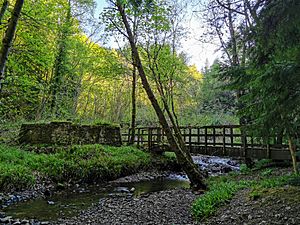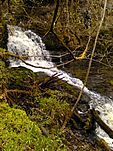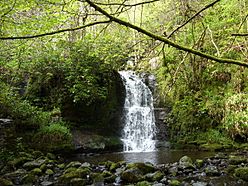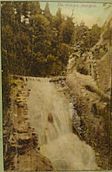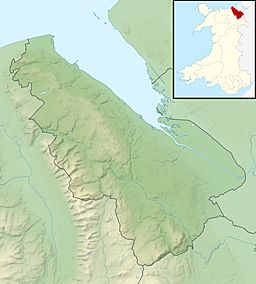Nant-y-Ffrith facts for kids
Nant-y-Ffrith is a beautiful place in Wales. It's a stream and a valley full of trees. This area sits right on the edge of Flintshire and Wrexham County Borough. The stream starts in the open moorland near Llandegla. It then flows past Bwlchgwyn village and into a deep, rocky valley. Later, it goes under an old railway viaduct before joining the River Cegidog in a place called Ffrith.
The woodlands here have some deciduous trees, which lose their leaves in autumn. But mostly, you'll see conifer trees. These were planted by the Forestry Commission after the Second World War. The woods are home to many plants and animals. You can find different ferns and mosses. Birds like the wood warbler and redstart live here too. In the 1950s, people came from far away just to hear the nightingales sing in the valley. Their songs echoed beautifully!
You can also find old, abandoned silica quarries and lead mines in the area. People might have started mining for lead here as early as Roman times. These old mines have left behind several interesting caves.
Contents
Ancient History of Nant-y-Ffrith
The mountain on the Flintshire side of Nant-y-Ffrith is called Penllyn. In Welsh, 'Pen' means 'head' or a high point. This name comes from ancient times. Long ago, people built roundhouses on Penllyn. Foundations of these old homes were found in the 1960s and 70s.
The name Penllyn might have once been 'Pen llan y gwr'. 'Gwr' means 'man' or 'leader'. This suggests it was an important place for an ancient Welsh leader or tribe. 'Llan' here probably meant a 'woodland clearing', not a church. This makes sense because people would clear trees to build a hillfort. There was another hillfort nearby in Bwlchgwyn. Both forts were likely built by the same ancient people.
Nant-y-Ffrith Hall: A Grand Past
Nant-y-Ffrith Hall was first built in 1850. It started as a hunting lodge, a place for hunters to stay. Over time, different owners made the building bigger. They also created beautiful gardens around it. The hall used to host an open day and garden party every year for local villagers.
Sadly, the hall slowly fell apart. During the Second World War, it was used to store ammunition. It was finally taken down between 1947 and 1950. Today, you can only see a clear space in the woods where it once stood. You might find some scattered stones and unusual plants like rhododendrons that were part of its old gardens.
Nant-y-Ffrith Waterfall: A Hidden Gem
Hidden among the trees, about halfway down the valley, is a large three-tier waterfall. It's about 100 meters upstream from a small wooden footbridge. This waterfall is the biggest in the Flintshire and Wrexham area. The next biggest is Dyserth falls in Denbighshire.
Even though it's big and important, it's hard to get to. There isn't much information about it for visitors. To reach the bottom, take a small path on the south side of the valley. It's about 20 meters upstream from the wooden bridge. To get to the top, use a path from a bend in the forestry track. Look for a sign warning about steep ground. Both paths are steep, uneven, and can be slippery.
When Nant-y-Ffrith Hall was popular in the late 1800s, steps were built up the rocks. These steps allowed people to see all parts of the waterfall. But like the hall, these steps fell into disrepair. Today, most of them are gone. Only a small section remains near Wedding Cave.
Nant-y-Ffrith Reservoir: Water for Villages
Quick facts for kids Nant-y-Ffrith Reservoir |
|
|---|---|
| Location | Wales |
| Coordinates | 53°4′11″N 3°7′52″W / 53.06972°N 3.13111°W |
| Type | reservoir |
| Primary inflows | Nant-y-Ffrith |
| Primary outflows | Nant-y-Ffrith |
| Basin countries | United Kingdom |
This is a small reservoir located near where the Nant-y-Ffrith stream begins. It supplies water to villages west of Wrexham. Building work started in October 1868. By February 1871, it was already providing water! The Brymbo Water Company built it. Now, Hafren Dyfrdwy owns it.
Many birds live around the reservoir. You might see great crested grebe and coot on the water. In the plants nearby, there are sedge warblers and reed buntings. In the fields around, you can spot lapwings and curlews.
Images for kids



